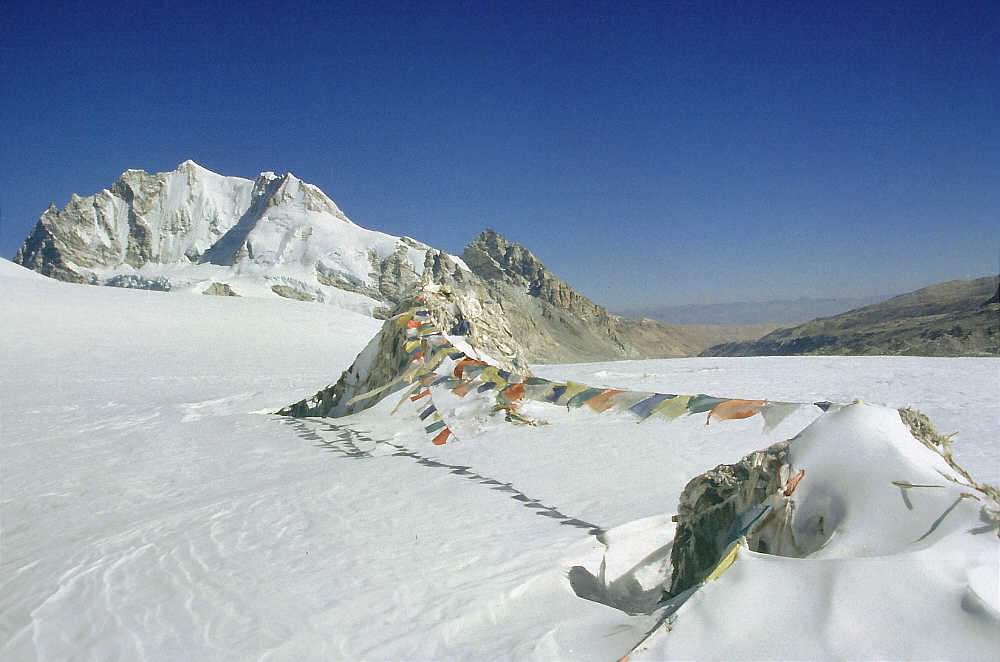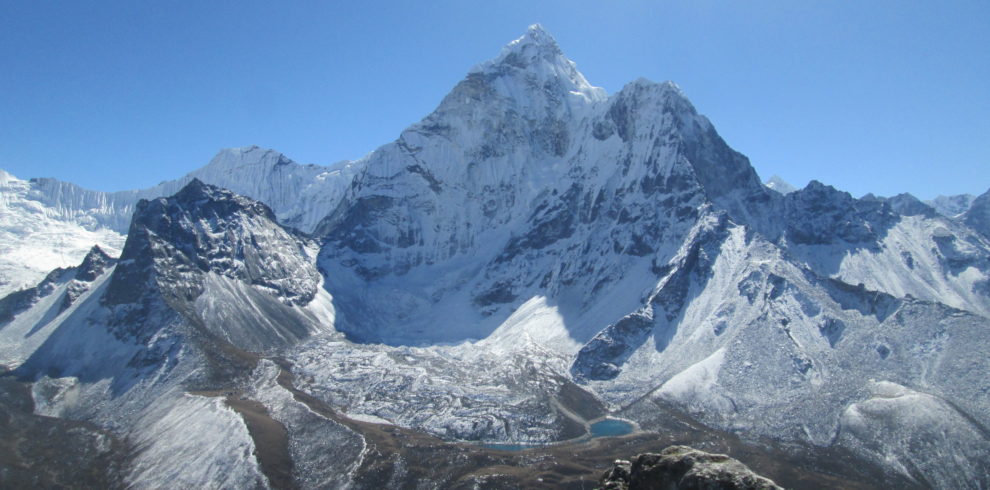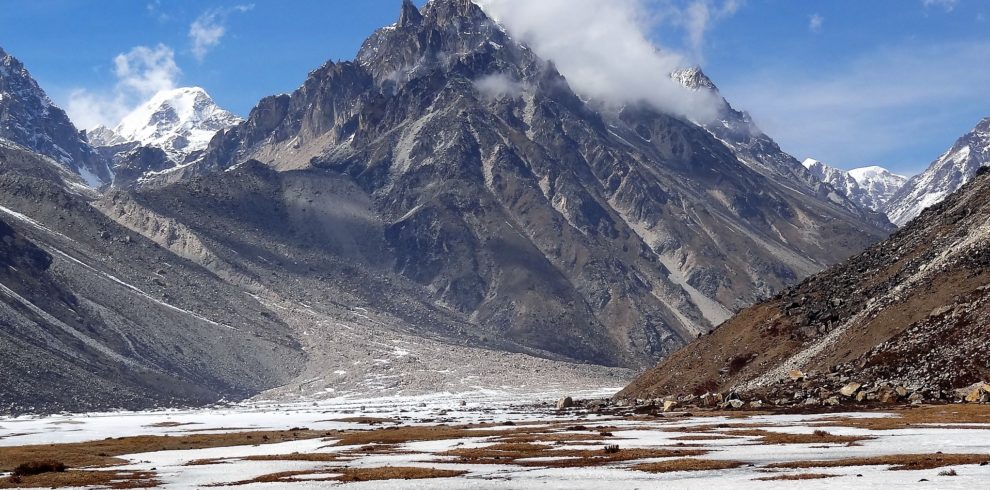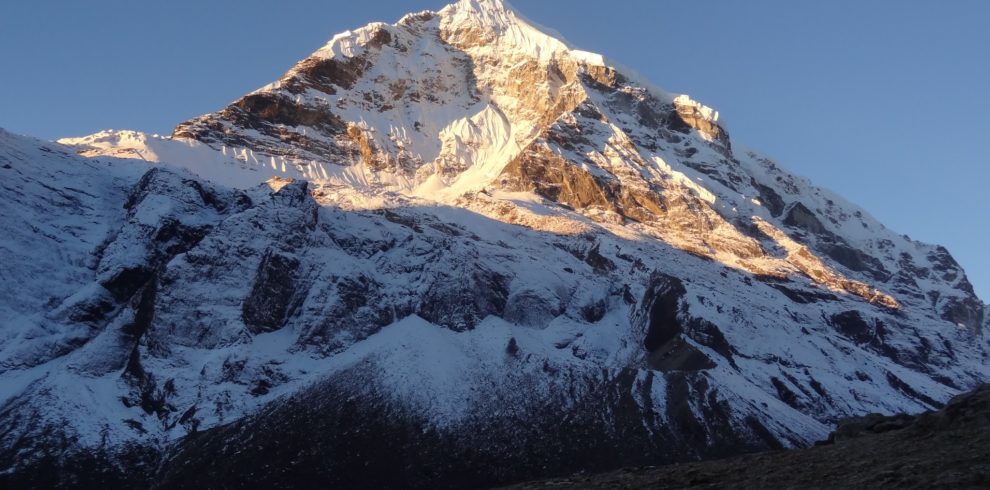Nangpala Pass Trek is one of the most beautiful trekking in the Everest region. It is near to the Tibetan border of the Everest Himalayan region. The North of Khumbu region Nangpa la high pass (5716m) the border for the Khampas. Since 700 years ago, they migrating from Tibet into Khumbu Valley. And now they have become Sherpas of Khumbu valley. Khampas came initially been from eastern Tibet. However, they fled from religious repression to the west in the Chooyu base camp of the Tibetan site. It is one of the astonishing seldom walked-on treks in Khumbu. But very rewarding for Everest hiker. Nagpala pass trek starts from Namche and it takes 5-7 days. Nangpala pass can perfectly be combined with continuing and crossing the Renjo La to Gokyo if we have time.
The most beautiful time to explore this Nangpala pass area is at the end of the monsoon. Meanwhile, flowers pop out in the Nangpala pass trek. It gives the trekkers the illusion that they are walking on textured carpet. However, Trek goes through Lukla-Namche Bazaar and Thame are Sherpa villages. Usually, trek follows Ancient trails thread towards the remote valley of Khumbu beneath. The caravan business, remoteness, the biggest glaciers in the entire of the Khumbu.
We need a tent and Stove for 4 nights and days so a lot of things to carry food and camping stuff. The trail through the glacier rumble was easy to find just to follow the yak poo. Also, we have can see the border Himalayas from top of the Nangpala pass. we have to walk in the icy route and trek can be longer with combining the Himalayas route. We have various clients review regarding this trip.
Dramatic take on/off in Lukla gateway to Cho-Oyu base camp
Camping trek near to Tibetan border Himalayas
Sherpa Culture and tradition hub
Many High suspension Hanging Bridges during the trek
Tibetan Buddhism and practice
Closure view of Himalaya route to Renjola Pass and Nangpla Valley
Highest Nangpala pass Cho-Oyu base camp viewpoint highest Mountain Khambu (roof of the world)
Breathtaking view from Mt Everest Mt Makalu and Glaciers
Comfortable Accommodation and hygiene meals every day served
Acute Mountain Sickness friendly itinerary
Scenic Mountain flights from Lukla to Kathmandu
Closure view of Himalayas in route to Everest Base Camp
Explore Namche Bazaar, the capital of the Sherpa people
Explore Khumjung Village and the museum, Hilary School
Magnificent view, Khumbu valley and Glaciers
Watching the world’s highest Mt Everest with Mt Ama Dablam and more
Everest base camp as well Island peak and surrounding
Itinerary
After landing at the Tribhuwan International Airport. You will be greeted by a representative of Everest hikers who will drop us off at our hotel according to your recommendation
The early day we start tour Pashupatinath temple, Swayambhunath stupa and Bouddhanath stupa which are all world heritage sites. The Durbar Square sheds light on the life of the Gorkha royals in ancient times, which we can explore by some short of hiking, Pashupatinath temple is one of the most important places of pilgrimage for all Hindus religious. Swayambhunath is also known as the Monkey Temple and Boudhanath Stupa is one of the largest stupas in the world, where we can view most of the valley and surrounding mountains. At noon, we are introduced to our trekking guide team and discuss the trek in Explore Manaslu team. Overnight in Kathmandu.
We take an early morning adventures flight to Lukla your Everest treks begin now. We meet the rest of our team in Lukla after breakfast we start our trek. We walk on a trail that gradually descends to Cheplung village from where we get a glimpse of Mt. Khumbila, a sacred mountain which has never been allowed to climb. From here, we gradually descend until Phakding village. Overnight in Phakding. Included meals: Breakfast Lunch Dinner in the same lodge.
Our trail leads through a pine forest and we continue our walk on the trail that goes north up the Benkar valley and for sale. We cross Dudh Koshi River and pass Chumoa and Monjo villages before reaching the entrance of the Everest National Park. All these villages are on the edge of the river, Then after crossing a suspension bridge, we pass Jorsale village and walk alongside the Dudh Koshi and Bhote Koshi rivers. We ascend steep trail around 2 hours continue to reach Namche Bazaar which is the gateway of the Everest region. Overnight in Namche Bazaar. Included meals: Breakfast and Dinner in the same lodge.
We will spend 2 night in this village for acclimation. Do tour Namche Bazaar which is the primary town of the Everest or Khumbu region and has government offices has lots of ATMs, internet cafes, shops, restaurants, and a colorful market. We can hike-up to Sagarmatha National Park and enjoy the sunrise over the Himalayas including Mt. Everest, Lhotse, Nuptse, Ama Dablam, Thamserku, Kongde and more...If we are interested in a day hike, we can trek to Khumjung village where the Hillary school and some museum belongs. Overnight in Namche Bazaar. Included meals: Breakfast Lunch Dinner in the Same lodge.
On this day trek head to westwards with the view of Kwangde (6,011m) and the waterfalls cascading off its flanks. Follow the Bhote Koshi as the trail goes high on its bank through rhododendron forest. Cross river, look back down the valley for beautiful views of Thamserku (6,623m) and more view of Khumbu. Keep climb up through rhododendron forest to pasture lands in front of village of Thame. We will camp in meadows at the edge of the village. An hour climb to the Cliffside monastery is of great for the day.
What's included in the cost?
- Airport / pick up & transfer by car / Van.
- Domestic flight ticket KTM/Lukla both way domestic airport tax
- 3 nights’ accommodation with breakfast at a 3*** hotel in Kathmandu.
- Meals (breakfast, lunch, and dinner) with Tea & coffee and hot/cold water during the trek.
- Teahouse Lodge and Tented accommodation during the trek.
- Everest National Park Permit and all necessary permits.
- All Camping Equipment’s (Tent, mattress, dining tent, kitchen tent, toilet tent, kitchen, etc.)
- Guide & support staff and their insurance and salary, foods, transport.
- The required number of local staff and porters to carry your luggage during the trek (We assign one porter for every two guests).
- Office Service charges and governments.
Cost doesn't include
- Any meals in Kathmandu Beside breakfast.
- Travel insurance (we would significantly be happy to assist).
- Both way International airfare
- Nepal Tourist Visa fee and more.
- Items and expenses of personal natures.
- Any kind of alcoholic drinks, cold drinks, laundry, phone calls, internet Etc.
- Personal Trekking Equipment’s like sleeping bags, jackets
- Emergency Evacuation (Helicopter Rescue).
- Any other costs whatsoever, that is not mentioned in the cost included.
- Tips for guide, porters, driver...
- Any costs which arise due to a change of the itinerary, due to landslides, political disturbance, and strikes, etc.
Check Gear list for Everest hiker
In most of the causes before start our adventure, we’ll spend a day or part of a day doing some casual sightseeing in world heritage site valley surrounding before we leave for the trek, and we’ll check gear when you arrive if anyone needs for the trek. Please have photos, passport photocopy airline tickets to re-confirm and insurance information ready if needed. Let us detail.
Recommend Day-pack for Everest hiker
We recommend a 30-45 liter Day-pack for each in case of porter hiring. Better to have it too large than too small, as on pass days you’ll want to carry more when you need it. Most have internal water bladders built-in, which are good to have it for any situation. Make sure it’s comfortable before leaving home. Mines are 55 and 65 liters.
Generally, if you are going to hire porter in your daypack, you’ll be carrying 1 or 2 liters of water, a wind/Gortex/soft/ hard-shell jacket, wind/rain pants, hat & gloves, extra socks, sunscreen, snacks, water purifying tablets or filter, camera, a plastic bag or pack-cover and maybe a down jacket. Another remaining porter will assist you.
Packing/Storage
It’s easiest to pack and unpack from a duffel-bag, do for the most natural, porters to carry as well… Inexpensive and/or sound quality duffel are available in Kathmandu, but we can provide upon your request but it’s best to invest in a robust and waterproof duffel such as a North Face. You can leave/store extra gear in Kathmandu at our office storage room free of charge.
Extra Gear & Villagers
If anyone has old/extra/used gear of any sort, bring it along if you have room in your duffel you can donate it for porters and some orphans center or donation for villagers.
Our porters & staff also appreciate it can be old shirts, jackets, pants, fleeces, shoes to your old trekking socks. We often have a raffle on the first day of the trek, and each porter will get at least one ‘new’ thing, which is fun for them.
Recommend Snacks for Everest hiker
It’s always good to have some snickers or bars at lower elevations. You crave terrific things at altitude, and often need energy in a way that you usually don’t at lower altitudes energy bars, electrolytes, etc are essential for long days or passes. Lemonade mix, Emergen-C, Tang, etc great to have for hot days in your water bottles can make huge differences. If anyone has a favorite cookie/biscuit, bring a package to share in the tent in the evenings with staff if you want. And anything else that you can bring particularly likes.
Water Purifiers & Filters
You can bring an MSR ceramic purifying/filtering pump along on the trek which everyone can use to pump freshwater in the evenings for the next day’s drinking water, ecologically the best way to get water in the Himalaya’s fragile trekking regions. Bring your pump, UV purifier or iodine tablets to have the capacity for fresh water whenever you want en route. Please bring at least unbreakable plastic/metal water bottles.
What we need for Everest trek
A copy of your travel medical insurance (just one sheet with policy number, name, and international contact numbers) as well as a password photocopy.
A copy of your Passport (front page) and Nepal visa
3 Visa-sized photo
Cash for Everest trek
We run trek basis on beautiful during the trek for drinks, snacks, candy bars, biscuits, beer, etc. There’s some good shopping in Namche, sometimes a chance to buy locally made products. For tipping the crew we recommend about $100 per person in Nepali rupees or USD. There are ATMs in KTM which give you 350 USD, and many money changers, banks, etc available in Kathmandu and Lukla. In Namche, you can change TCs or cash, and some other places cash but we recommend you do it in Kathmandu. Guide also has extra rupees with them if anyone runs out and needs to borrow. For each Everest hiker, $250 is an excellent amount to change when you arrive in KTM.
Camera/ mobile Batteries recharge system
There are now many places to recharge batteries in the Everest, Annapurna, Manaslu and Langtang region so bring your camera battery chargers otherwise bring your solar panel. We recommend always bringing extra batteries as it takes time to charge and there is often a line in the busy time, charging is not always available and it can get expensive to charge your batteries up higher!
Washing & Showers in Everest trek
Showers are almost always available at the lodges of Everest regions. But they’re not cheap generally per head 3-5USD up to. So budget some extra cash if you like to shower daily! You can have (at no cost) a ‘warm washing bowl’ to wash up with. As for clothes, bring a small package of soap powder, and you can either wash your clothes yourself or laundry available in Namache our porters some money to wash them for you! That sometimes works.
Sleeping bag for Ebc trek
Down-filled sleeping bags rated to -10º are best because high altitude nights will be fresh for hikers but for peak climber more than…Good down is fluffy, light and thick. A muff makes a big difference to the overall warmth of a bag and a mummy bag is generally warmer than a rectangular one. If your bag is rated for a higher temperature add a fleece sleeping bag liner to add warmth to the alpine zone.
Day-pack for Everest base camp trek
This should be comfortable in your choice, with a right waistband that transfers some of the weight to the hips. It needs to be big enough to take a jacket, fleece, drinking water, camera and odds and ends you might like during the day which should be always with you.
Duffel Bag for Everest hiker
If you travel with porters, bring your gear in a duffel bag which helps to excess easy. Several companies make good duffel bags with a zipper along the side for ease of entry choose the best one. Get a bag that is durable and has a sturdy zipper some time it makes different. A duffel bag 40cm in diameter and about 80cm long is large enough to carry your gear and will usually meet the weight limit of porters and domestic flight rules.
Recommend Trekking Boots, for Everest trek
To finish happily trek you need comfortable feet. Quality boots have good ankle support, plenty of toe room for long descents, a stiff sole to lessen twisting torsion and are light, due to you don’t tire. Look at the inner lining – leather is good and Cambrelle is even better, a material that eats smelly foot bacteria and makes the extra relief. Good lightweight trekking boots or light all leather boots are ideal for a long day trek. Avoid arriving with brand new boots that you have not yet used before! Walk-in your new hiking boots on some steep hills and make it smooth that will test trouble spots before you leave home. The longer the trek, the better the boots you need, so took the best one for a happy journey.
Socks,
In the low country area, your feet will be warm or even hot while walking so quality cotton mix sports socks are excellent. Three to four pairs are enough for the trek. Thick trekking socks are better for higher up because you may walk in the snow, and evenings are cold where you can exchange. We suggest you bring four pairs or even 1 more. Mostly modern trekking boots fit snugly so wearing two pairs of socks at the same time is impractical to think twice.
Camp Shoes,
Luxury for your feet at the end of the day: sandals or running shoes is the best idea.
Fleece top,
Most trekkers consider this is essential, but alternatives are a thick thermal top or a light down jacket. In Kathmandu, you can get cheap Korean fleeces but they are not the best quality you needed.
Down Jacket or fiber-filled jacket,
Down clothing has the advantage of being light and compressible for alpine. A down jacket will stuff into a small space when packed, yet puff up. You should bring a good down jacket on all treks from your country or can buy in Kathmandu. Most ski jackets that have been used in your country are not warm enough and most so-called expedition parkas are too heavy and bulky. Don’t bring both a heavy and a light down Jacket; choose one that will serve both purposes, preferably ideal one with a hood that is also stuffed with down. If you feel extremely cold at high altitude, you will likely wear your down jacket inside your sleeping bag.
Wind or rain jacket
During the day trekking, you can use windproof, Waterproof and breathable. Plastic ponchos or non-breathable raincoats are not suitable for the trek.
Fleece/sweatpants,
Great for the chilly evenings, thicker is better and polypro is better than cotton in high.
Day-wear shirt,
T-shirts are favorite but a shirt with a collar and long sleeves are more practical during the day or in the evening. Regularly you can use two so you can swap damp for dry. Look one for shirts made of quick-dry fabrics rather than cotton.
Trekking pants,
You will live in these. Light material, loose-fitting, and dark-colored are best.
You can survive with only one pair but you have to bring two; get dusty or muddy so a change is a good idea. Cotton cheapies some marks in the local fashion, it is not necessary to have gore-tex or waterproof pants.
Neck gaiter,
For winter trekking they are the best for staying warm you need it, A fleece triangle with a Velcro fastening works well and is easy to pull up when the yaks stir up trail dust.
Trekking poles,
Useful, especially on steep, rough terrain, but if you are not used to using them you will not miss them someone who loves to do photography thinks twice.
Sunglasses,
Highly recommend good one suitable for snow, as it is bright up there, but specialized glacier glasses. Contact lens wearers report very few problems except cleaning them in the conditions it’s your matter. Ski goggles are unnecessary for trekking.
Mittens/Gloves,
These don’t need to be fancy (pockets are the warmest solution to cold hands), so local Kathmandu fleece gloves are excellent but you need it.
Water bottle,
Should be a one-liter size, except boiling water, and be leak-proof. You have to bring 2 or liter capacity in all. Sometimes mini Thomas a metal bottle can double as a hot water bottle on cold nights.
Torch,
LED bulbs are best for mountains. You will need a lamp for reading after dark, and for finding your way to the outhouses. A headlamp is excellent for climbing although many people prefer the second torch it’s enough.
Toiletries and odds and ends,
Bring essentials for the trek only otherwise you can buy in tea houses. There are a surprising number of showers or buckets of hot water available in the hotel. The smallest tube of toothpaste is perfect for a month in your favor. Roll-on deodorant can spare you grief with your tent partner toilet paper need. Hand cleaner in a bottle (“Parallel” or similar) is a good idea, it would be better for the environment than “handy wipes”.
Towel,
Bring only a small one for trekking, or consider using a sarong. Mountain shops sell towels made of a quick-dry fabric which is cost around 10USD. In Kathmandu, a city hotel does supply towels. Sunscreen and lip care with sun protection extremely needed during the day sun is intense at altitude, especially after snow, and you will want to use these most days.
Water purification,
One bottle of iodine tablets between two, Douglas or Potable Aqua is the best one. Shops in Canada sell Pristine, which is a good option. We tend to use boiled water from the lodges but occasionally we need to take water from the streams. The use of a mineral water bottle is discouraged from an environmental point of view and the higher it costs more.
Snow gaiters
These are not needed, but bring them if you already have some in case we get or cross a pass about 5400M high or you are coming in the winter season.
Evening camp wear,
Around the evening camp, you can wear camp shoes, lights sandals or leather boots. No matter what altitude and what season the temperature can get to -10º after dark. By far the best clothing is:
+ A down jacket, medium weight
+ Thick fleece pants
+ Fleece hat and neck gaiter
+ Thick shoes with wool socks
Available in Kathmandu or bring from home that we need.
1) Sleeping sheet
2) Duffel Bag
3) Trekking pants
4) Wind pants
5) Fleece top
6) Warm hat
7) Light gloves
8) Toilet paper
9) One litter of water bottle
10) Pee bottle
11) Lip care
12) Torch
13) Snow Gaiters
14) Water purification
Bring from home
1) Sleeping bag
2) Daypack
3) Trekking Boots
4) Running shoes
5) Socks
6) Camp shoes
7) Rain jacket
8) Nightwear top
9) Neck gaiter
10) Daywear shirt x2 or 3
11) Underwear
12) Sun hat
13) Sunscreen
14) Sunglasses
15) Toiletries and odds and ends
16) Small towel/sarong
17) Personal medicines
18) Camera
19) Money pouch/belt
20) Passport photos 2x
21) USD40 cash for a visa (30 days visa)
Nangpla pass trek
Nangpala pass is nearby Tibetan border. It is about 5800m pass. its completely wild Valley trek. Its just few kilometer ways from Famous Mt Cho Oyu base camp. We head north from Namche Bazaar. After when we been Thame we walk another valley not fallowing the Renjola pass and Gokyo Valley.
We are going near the border not going to pass Nangpala. We walk nearby Mt Cho Oyu base camp. it would be the great escape from the regular trek with camping crew few days.
It is not that problematic trek but has elevation. So we must acclimatize with weather and Altitude.
We need all the camping equipment for the trek and few days for tea house trek.
Nangpala pass trek is 5806m. its 39 km northwest from Everest. its traditional pilgrims’ route and Trade to Tibet for Everest region People.





